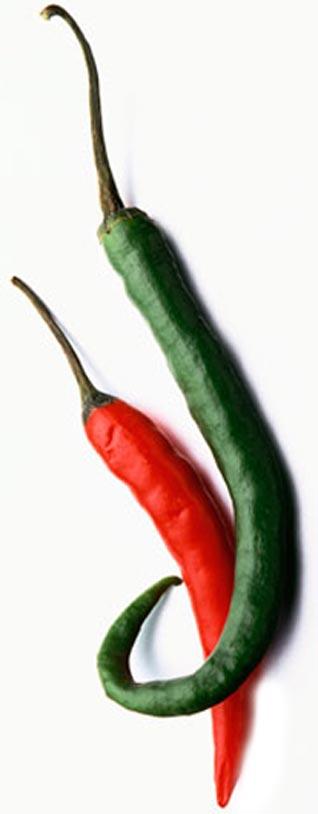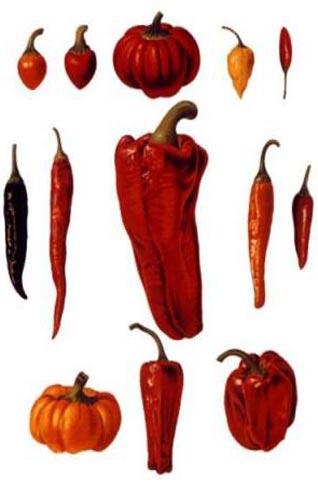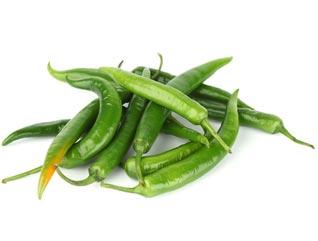Cuisine
How Do You Chill Chillies?
by OLIVER THRING
I love chillies.
You love chillies.
But the problem with chillies is that they tend to attract insufferable willy-waving nutty readers who think that eating a piece of fruit immediately turns them into testosterone-sodden paradigms of brave, muscled blokiness.
Visit a curry house in a student town on a Friday night, and all too often you'll hear the bark and bray of some team or other from across the room: a beefy herd waheying as one of its number gulps and weeps over a mutton phaal, a bowl of red, raw, sadistic chillies burning at his side. The jocular jocks will then taunt this luckless chump with tooth-sucking promises of ring-stingers and agonised, searing squits on the clenched and bitter morrow.
This pathetic, flaccid laddery trebly demeans a
noble fruit. It sidelines the flavour and fragrance of chillies,
pretending that heat is all they have to offer. It discourages tentative
or cautious people from trying the peppers, and it promotes the
ludicrous idea that there's something macho in enjoying heat. A
seemingly rather demure Indian lady holds the world record
for chilli eating. In two minutes she ate 51 bhut julokias - 200 times
hotter than jalapeños - garnishing her win by rubbing the seeds into her
eyes.
Chillies are native to the Americas, and humans
domesticated them around 6,000 years ago. Columbus, or specifically his
physician Diego Álvarez Chanca, brought the plant to Europe in 1494. The
ignorant inhabitants of the Old World called chillies "peppers" because
the fruit's heat supposedly resembled the spice's.
One little gastronomic curiosity is that, although Europeans spread chillies around the world, they didn't particularly take to it themselves, and the peppers became far more popular elsewhere. Historically, anyone who lived north of Naples has barely touched the stuff, although cayenne pepper, paprika and chilli powder have been available across the continent for centuries. Spanish occupiers in Mexico took the chilli to the Philippines, India and China, where it was swiftly co-opted into the local cooking. At a Portuguese trading station in Goa, chillies joined an Iberian pork and vinegar dish to create the now maligned vindaloo.
The "heat" of chillies comes from a compound called capsaicin and its relations, alkaline substances that affect the pain receptors in the mouth. These transmit to the brain the information that the person has eaten something hot, and the brain responds by releasing endorphins and raising the heart rate. Chillies thus offer a natural, largely safe "high", though that pleasure of course commingles exquisitely with pain.
These almost narcotic qualities can seem to render the fruit addictive. We all know people, indeed cuisines, that find any savoury dish incomplete without heat: a meal in Thailand, Sichuan or Bhutan, to name just three, would be inconceivable without chilli. Love the fruit though I do, I think this is a shame: chilli can obliterate a dish, bullying other flavours into mute insignificance. Mark Hix is quite right when he says it doesn't have to "blow your socks off".
In 1912, the improbably named Wilbur Scoville developed the first system for measuring the strength of chillies. He designed his scale around the number of times a chilli extract needs diluting before humans can no longer discern its heat. A green pepper, which contains no capsaicin, is zero Scovilles, Tabasco around 2500 and scotch bonnets (among my favourites) are anywhere between 100,000 and 325,000. Police pepper spray is 5m Scovilles, making it potentially lethal if inflicted on asthmatics. Pure capsaicin broils terrifyingly at 15m: laboratory workers handling it wear goggles and gloves and breathe through respirators. Exposure even to relatively small quantities of pure capsaicin can lead to permanent blindness or death.
But just as its flavour mixes pleasure and pain, the potentially dangerous irritant capsaicin can do us good. While opiates often lead to tolerance or dependence and can cloud and fug the brain, capsaicin derivatives can be effective analgesics, used to assuage the worst of shingles and arthritis. The fruit may lower blood pressure. And despite what many people think, chillies don't cause stomach ulcers or otherwise harm the digestive system. Because capsaicin speeds up a person's metabolism, it could even help digestion.
Beyond the laddy horde, the British taste for chillies seems to be maturing: sales were up 42% between 2007 and 2009. Food writer Tom Parker Bowles adores them. "What is heartening is the increased range of chillies in the supermarkets," he wrote to me. "10 years back, you'd be lucky to get some drab, Dutch dullard. Now even the most basic places have at least two or three." Outfits like the South Devon Chilli Farm do very well from selling bottled sauces and chilli-flavoured chocolate (the pairing is standard in Mexico).
Perhaps what I love most about chillies is this ongoing relationship. Chillies reward devoted customers, who learn to love the prick and tingle of their nerves. One hesitant addition of a sliced scud can lead to carefree use of vicious and bulbous and heady scotch bonnets. But caution is still worthwhile. As Parker Bowles says, "Beware of the super hot extract sauces, the likes of Dave's Insanity Sauce and Blair's Reserves. These are more lethal weapon than taste enhancer and should be treated with care."
It's worth remembering that, pace almost every telly cook, the hottest part of the chilli is the white internal membrane, and not the seeds. Yoghurt and proper booze are best if the pain is excruciating: capsaicin doesn't bind to water molecules, and beer is too close to water.
But many of us relish the thrill and pain, the agony and ecstasy of the tropical pepper.
Some, it seems, will always like it hot.
How do you chill the chilli?
[Courtesy: The Guardian]
September 1, 2010





